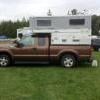Interesting idea: Charge camper battery while driving by using the truck's RV style trailer plug wiring. That's basically what people are doing when they tow an RV trailer, but there are several things to keep in mind.
First, what's your source of power? You need a plug receptacle on your truck with a 12V charging circuit. One of the pins in a 7-pin receptacle provides this constant power but a 4-way doesn't (it only has brakes, turn signals and ground).
Next, check to see if the 12V charging circuit is on any time the truck ignition is on but off any time the truck ignition is off. If the charging circuit is still on when the truck ignition is off, you'll just run your truck battery down unless, of course, you add an isolator to the circuit.
Finally, remember that you'll be charging your camper battery through a very long set of wires that run all the way from your truck battery to the rear and then forward again to your camper battery. There will be a voltage drop that will not let your camper battery be charged anywhere near all the way.
Here's my situation: 2011 F-250 with 5th-wheel package including a bed-mounted 7-pin receptacle. I tested with my voltmeter and confirmed that the 12V pin on the receptacle goes dead when the ignition is off - no isolator needed. I bought a 7-pin plug and connected up the power and ground for the camper. I also connected the camper running lights to the tail/running lights pin on the plug.
This works great for my needs but, honestly, I think my roof-mounted solar panel does a better job of charging the camper battery, even while driving. During daytime, of course.
It sounds like BBZ has a portable solar system that's not deployed while driving. So a connection to the truck's charging system is easy to try, assuming you have a 7-pin receptacle already. Even if it keeps the camper battery at 70%, that's something.
Good luck



















